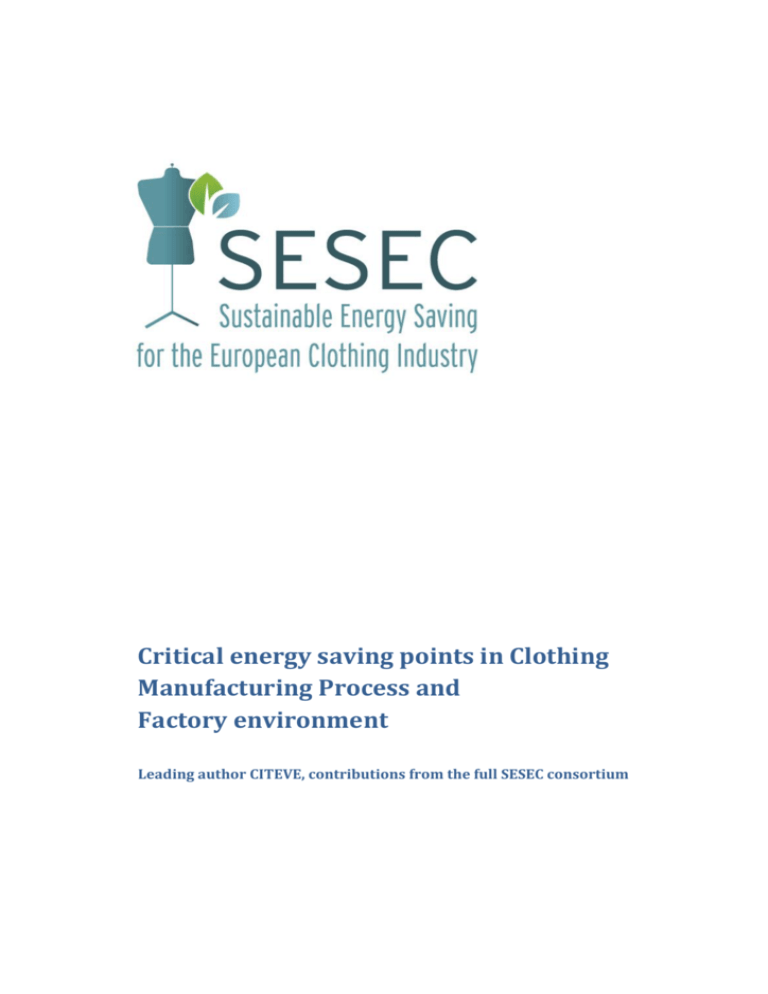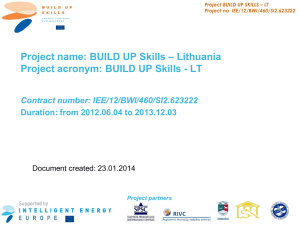Critical energy saving points in clothing manufacturing
advertisement

Critical energy saving points in Clothing Manufacturing Process and Factory environment Leading author CITEVE, contributions from the full SESEC consortium Table of Contents 1. About SESEC ........................................................................................................................... 1 2. About this document ............................................................................................................. 1 3. Executive Summary ............................................................................................................... 2 4. Critical areas ............................................................................................................................ 3 5. Production machines ....................................................................................................... 7 Compressed air.................................................................................................................. 9 Lighting .............................................................................................................................. 10 HVAC (heating, ventilation, and air conditioning) …………………….………… 11 Heat (boiler and gas/fuel supply) ................................................................................ 12 Vacuum .............................................................................................................................. 14 Logistics ............................................................................................................................ 15 Conclusions and next steps ................................................................................................ 2 Disclaimer: The sole responsibility for the content of this [webpage, publication etc.] lies with the authors. It does not necessarily reflect the opinion of the European Union. Neither the EACI nor the European Commission are responsible for any use that may be made of the information contained therein. IEE/11/827/SI2.615931 – SESEC 1. About SESEC Based on industry-driven ideas, SESEC is a cooperation project designed to support Energy Efficiency in the European clothing industry. Co-funded by the European Union through the IEE programme, SESEC develops and offers Energy Efficiency tools, information and training for companies to assess their consumption and implement corrective measures considering cost-effectiveness. Coordinated by EURATEX and run by a nine partners consortium, SESEC started in March 2012 and last thirty months. Periodic information on progresses and cooperation opportunities with organisation which are not member of the consortium are released through the SESEC website hosted in www.euratex.eu. 2. About this document This document is an extract of a SESEC working document elaborating on critical energy saving points within the clothing industry. This provides information from-thefield about energy consumption in selected European clothing enterprises, about their potential for energy savings, as well as on opportunities for energy saving measures and indicators for monitoring the achieved results. This document represents an intermediate step of the SESEC project activities, the following conclusions are provided for reference and cannot be considered as final. 1 IEE/11/827/SI2.615931 – SESEC 3. Executive Summary This document supports concerned parties (including company managers and staff) to identify and organize measures for energy savings in clothing manufacturing. The first step is prioritize the search for the areas where the biggest saving potentials can be found and, preferably, ally them with the lowest investment. Search must start at process / production equipment level and gradually move to other levels such as secondary consumption, energy distribution and energy production, the end result being the identification of critical energy saving points in the clothing industry. After critical points are identified, measures including those recommended by other tools developed in SESEC, can be progressively implemented and efficiency increased. The information contained in this document is based in know-how and the experience in production fluxes and energy audits in clothing industries of CITEVE (www.citeve.pt) and the other partners of the SESEC project. Key contributions were provided specially by PIRINTEX whose suggestions completed and enriched the document. Data provided in this document are based in both know-how and field work performed directly at companies premises. 2 IEE/11/827/SI2.615931 – SESEC 4. Critical areas A typical production sequence is shown in the following image. At process / production equipment level we can see in the following figure where and what kind of energy is consumed in the typical production sequence. 3 IEE/11/827/SI2.615931 – SESEC In terms of number of steps and as shown, the use of electric energy is universal, then the compressed air and finally a thermal source. Next at the plant level distribution and energy production is shown in the following image. 4 IEE/11/827/SI2.615931 – SESEC Here we can identify the production and transport or only transport of energy to the several production steps and the secondary use of energy: Distribution on medium / low voltage of electricity to all consumers, whether for driving force, control, lighting or thermal output; Production and distribution of compressed air both for production equipment and cleaning; Production and distribution of steam / hot water for both production equipment and air conditioning; Production and distribution of conditioned air to both comfort and the upkeep of optimal environmental conditions for production; Distribution of fuel for direct burning on production equipment; Production of light for use in both productive and non-productive areas; 5 IEE/11/827/SI2.615931 – SESEC Vacuum of excess steam in production machines; Vacuum of fabric residues; Use of fuel for logistics. With the systematization of production, distribution and consumption of energy in the plant we can now seek critical points for energy savings at each level and area. The first critical issue is the inexistence of partial energy meters and is common to all levels and areas. Typically only the main meters from utility companies are present, i.e. only global energy is measured. 6 IEE/11/827/SI2.615931 – SESEC Production machines Most of the energy consumption of productive machines in the garment industry is for driving force. Similarly, the bulk of total electrical energy consumption is due to driving force so it makes sense that, in production, the critical points in the energy savings are electrical in nature. The electrical consumption of productive machinery is as linked with the technology used as its use, so we can divide the critical saving points in technical and behavioral: Excess consumption through technical issues: Using motors in fixed speed; Use of low efficiency motors; Use of rewinded motors; Use of direct start in motors; Use star/triangle starter in larger engines; Uncompensated reactive energy; Phase imbalance due to poor distribution of single-phase equipment. Excess consumption through behavioral/organizational issues: Machines turned on without being necessary; Low load regimen; High downtime between loads. On the other hand it is also important to point out the losses encountered in the electric network from the transformer down to consumer. 7 IEE/11/827/SI2.615931 – SESEC The losses are mainly: Oversized transformers and/or at end of life; Undersized wiring; Phase imbalance; Overloaded switchboards. 8 IEE/11/827/SI2.615931 – SESEC Compressed air Compressed air is a critical point not only because is the most expensive form of energy in the plant but also its optimization is relatively easy. Thus the most significant losses in production, distribution and use of compressed air, are: Use of compressed air for cleaning as rule rather than the exception; Inexistent air buffer; Inexistent cut valves for air consumers; Leaks in the distribution network; Distribution network undersized; Produced pressure is greater than necessary; Oversized air compressor; Compressor operation in on-load/off-load control (without load management); Malfunction of network accessories; Hot exhaust air is wasted; High air temperature in compressor room. 9 IEE/11/827/SI2.615931 – SESEC Lighting Lighting in the clothing industry is of great importance not only because of its quality but also quantity due to the meticulous work and verification in the various activities, mainly in non-automated sub processes. The need to guarantee the amount of light is itself a clue to the demonstration of lighting as a critical point. Typically the clothing industry relies heavily on artificial lighting of the fluorescent type. Over-consumption in this area can also be divided in technical and behavioral issues. Excess consumption through technical issues: Reduced area for natural lighting; Use of outdated and low efficiency lamp technology; Use of ferromagnetic ballasts; Inexistent reflectors on fixtures; Over lightened areas; Use of general instead of located lighting. Excess consumption through behavioral issues: Dirty reflectors on fixtures; Lighting turned on unnecessarily. 10 IEE/11/827/SI2.615931 – SESEC HVAC Generally, in the clothing industry, the HVAC is used to maintain comfort usually having a strict connection with the employees and not with the product. The low thermal comfort leads to reduced productivity. HVAC systems may be entirely independent if refrigerant gas is used for hot and cold water production or partially interconnected when using the steam/hot water via the boiler/heat generator that supplies the production process. When analyzing this consumer it makes sense to divide the critical saving points in technical and behavioral. Excess consumption through technical issues: Undersized acclimatization; Obsolete systems; Lack of automatic control; Uninsulated ducts, pipes and fittings; Use of decentralized systems with individual controls; Low thermal characteristics in building construction; Accesses, such as windows and doors, not caulked; Malfunction of network accessories. Excess consumption through behavioral issues: Accesses are kept open during use of air conditioning; Temperature set-point higher than necessary (or lower if in summer); System kept on without being needed. 11 IEE/11/827/SI2.615931 – SESEC Heat (boiler and gas/fuel supply) In the clothing industry thermal energy is used in air conditioning, in finishing and preparation for sewing sub processes and, in some companies, for treatment. This energy can either be supplied by direct combustion of gas in the productive machines, or indirectly through production of steam or hot water. As mentioned before there are also cases of steam production through electricity, i.e. ironing. It is evident that the use of energy in an indirect way, although necessary, creates more points for losses than the direct supply. Critical points for excess consumption by indirect means: Boiler / Steam Generator oversized; Boiler / Steam generator poorly insulated or uninsolated; Produced steam pressure higher than required; Misadjusted burner; Unmodulated burner control; Uninsulated pipes and fittings; Leakage in steam / hot water network; Waste of condensates from the steam network; Malfunction of network accessories; Inexistent flue gas heat recuperation; Deficient maintenance / cleaning. Critical points for excess consumption through direct feed: Uninsolated consumer equipment; Misadjusted burner; Unmodulated burner control; Oversized ventilator or without control. 12 IEE/11/827/SI2.615931 – SESEC In those cases where wet treatment is used, we can also add: Unoptimized bath ratios; Energy in waste water is not recovered. 13 IEE/11/827/SI2.615931 – SESEC Vacuum In the clothing industry air extraction is used not only in HVAC systems but also for cleaning purposes. Vacuum systems are used to remove the excess steam used in the equipments of finishing and pressing sub processes and for suction of waste produced by cutting and sewing sub processes. In both cases fans are connected to a duct system, suction is made by zone and/or individual machine. Recurrently over-consumption in this area is due to: All or nothing utilization, i.e, even if only one production machine is in use the suction is being applied to all machines; Leakage in network; Extracted hot air is wasted (of steam consumer machines) Lack of electronic control and frequency variation. 14 IEE/11/827/SI2.615931 – SESEC Logistics Logistics in the clothing industry can be interpreted as all product and personnel movements in the company, this includes all sorts of transport belts, conveyors, but specially and more importantly, vehicle use. The use of vehicles is by far the primary source of energy consumption in logistics and is used mainly for raw material, sub product and product transportation from and to the plant. Although a difficult area to optimize some obvious inefficiencies can be found. Recurrently, excessive consumption in this area is due to: Use of forklifts that consume road fuels like diesel; Transport vehicles are "old" and "tired"; Lack of management in cargo optimization; Lack of management for route optimization; Lack of specific training for drivers. 15 5. Conclusions and next steps Despite growing concerns with energy, companies are still suffering from historical low interest in energy efficiency mainly due to the low ratio of energy costs / total costs and low internal knowledge on this area, accordingly there is an interesting potential for savings in the clothing industry. A wide array of technical and organizational solutions that range nearly all internal energy consumers is available, measure implementation is limited only by the referred lack of knowledge and financial availability, these drawbacks can be minimized by consultant intervention and credit availability. By analysing the Energy data of clothing companies1 a document including data from 27 energy audits across Europe, we can verify that main energy consumers are segment and country sensitive but as a rule “operating fluids”, “production” are dominant, in some cases “HVAC and ventilation” and “logistics” take a dominant position and finally “lighting” has a similar weight in all countries. Although in “operating fluids” compressed air production is included, the bulk of consumption is fuel (natural gas, coal, etc.), same with “HVAC and ventilation” who, depending on technology used, also relies heavily on fuels, so we can conclude that optimization on heat consumption and production is a priority. Because electricity has a wider use being involved in, basically, everything that is produced and how it’s produced a considerable amount of measures will surely be based on electrical consumers, especially in motor optimization. Having identified the critical points on energy efficiency the SESEC consortium proceeds further to roll out and test a methodology sustained by tools (based on excel files) for energy savings measures to be effectively applied by clothing company. The outcome is made available in the SESEC project website, hosted under www.euratex.eu 1 Document available on the SESEC website





